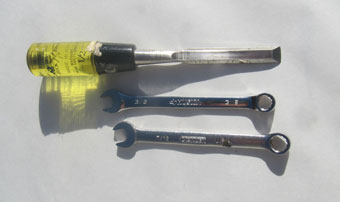The tools of our trade are our “bread-and butter,” and they must be kept under lock and key, as well as protected from the elements. Tools are costly, and your tools will make a great living for you if you treat them right.
A well-equipped toolbox containing the basic tools particular to your sign company is essential.
Buy the best hand tools you can afford, because cheap, low-grade tools are not a bargain! I’m talking about excellent-quality wrenches, hammers, saws, screwdrivers, flashlights, buckets, rope, and whatever else is essential to the completion of your project.
Be sure to buy a quality battery-powered drill with a charger and a spare battery. Always carry at least two (preferably three) rechargeable batteries.
Make sure the batteries are fully charged before leaving for the work site. When putting up a sign, there is nothing worse than having to wait on batteries to charge.
I like to carry a wood chisel and a few combination wrenches for unexpected challenges on the job as well.
Clear 100 percent silicone in a caulking-gun tube is another great product to have at your disposal.
You should have several ladder options in your lineup as well—a professional-grade stepladder, an extension ladder, etc.
Perhaps you should consider a few sections of scaffolding (if needed). Make sure the scaffold is solid. Many scaffold companies have “outriggers” that should come in the rental package.
Be sure to add the casters (locking wheels) to the scaffold. You’ll appreciate this small step the first time you move the scaffold on the job site.

When working from a scaffold, be extremely careful. You wouldn’t want to experience a fall, so make sure you wear your safety belts or harnesses at all times and tie-off to the scaffolds. Also an assistant should help you with large or heavy panels.
And make sure your scaffold has toe-boards to keep your feet safely inside the confines of the scaffolding.
If you’ll be painting inside or out, invest in a set of heat lamps on casters. These come in four- and six-bulb configurations.
Perhaps you would like to sandblast a weather-beaten and rusty piece of metal. I carry a small pressure-fed sandblasting pot to job sites and connect it to a compressor.
Be sure to adequately protect yourself here as silica sand is dangerous to breathe. Always use an air-fed helmet to keep as much of the silica dust away from your lungs.
You can never wear enough protection when working with compressed air. Protect your eyes, ears, nose, and any exposed skin.
Speaking of safety, don’t forget protective gear (goggles, gloves, long pants, long-sleeve shirts, etc.) and high-quality leather and/or rubber work boots. Working outside will expose you to the elements, so be aware of the weather and dress accordingly.
By Mark K. Roberts, a thirty-eight-year sign maker, a teacher of sign techniques, and the owner of The InterSign Company in Houston, Texas.











